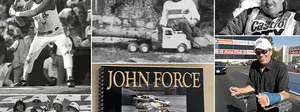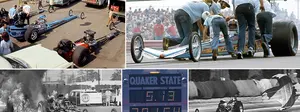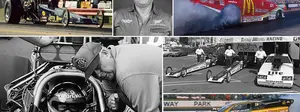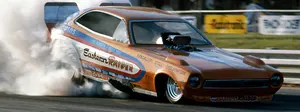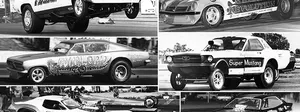

Herm Petersen, Part 2
 Less than seven months after being severely burned over more than half of his body when his race car overturned and caught fire at Orange County Int’l Raceway in July 1973, the indomitable spirit that sustained Herm Petersen before and since had him ready to return to competition for the 1974 season-opening Winternationals in Southern California.
Less than seven months after being severely burned over more than half of his body when his race car overturned and caught fire at Orange County Int’l Raceway in July 1973, the indomitable spirit that sustained Herm Petersen before and since had him ready to return to competition for the 1974 season-opening Winternationals in Southern California.
His comeback machine, pictured at right, was as special as the comeback, though not nearly as successful. Innovative chassis builder Woody Gilmore had dreamed up and then built his “car of the future” for Petersen and partner Sam Fitz, a Can-Am-inspired machine that looked as if it might be more at home on a road course than a straight-line quarter-mile. Its blue anodized bodywork draped over the chassis, covering the engine and both front and rear tires, with the rear wing integrated into the bodywork. Petersen had obtained backing from Olympia beer and Justice Brothers, whose names and colors adorned the sleek-looking machine.
Despite the serious nature of Petersen’s injuries and his ongoing recovery and future reconstructive surgeries, the mood on the team was certainly lighthearted.
“We were ready to leave the shop for Pomona,” recalled Petersen. “We all had CB radios then, and my handle had been ‘Northwest Terror.’ As I got in the truck, my good-humor crewman David Belyea said, ‘You have two choices for a new handle: ‘French Fry’ or ‘Bar-B-Q!’ So it’s been ‘Bar-B-Q’ ever since. We’ve had lots of fun with that over the years.”
Before heading to the racetrack in Pomona, they stopped Wednesday at Irwindale Raceway, just 10 miles down the highway, to shake down the new and unproven machine and to give Petersen his first passes since the accident.
“They pushed me down, and we fired it up, and it was just bitchin',” he recalled, a grin spreading across his face. “I made a half-pass and was so happy that I was crying at the other end. I’m back!”
 The new car – still powered by a Donovan engine when many were switching to the Keith Black late-model style “Elephant” engine -- didn’t come close to the 6.17 Winternationals bump established by Jim Bucher, but they loaded up and headed east to Gainesville for the Gatornationals anyway because, as the defending event champ, they were seeded into the field (a practice long since abandoned). He lost in the first round to Carl Olson with a 6.63 that wouldn’t even have been quick enough to qualify.
The new car – still powered by a Donovan engine when many were switching to the Keith Black late-model style “Elephant” engine -- didn’t come close to the 6.17 Winternationals bump established by Jim Bucher, but they loaded up and headed east to Gainesville for the Gatornationals anyway because, as the defending event champ, they were seeded into the field (a practice long since abandoned). He lost in the first round to Carl Olson with a 6.63 that wouldn’t even have been quick enough to qualify.
“The car did everything right; it handled perfectly, never did anything evil, but it was 200 pounds too heavy,” he explained. “It probably would have worked fine today with these cars having to weigh so much, but not back then, so we went back to L.A. and told Woody we had to have a conventional car, but there were two cars ahead of me, yet I had to have a car right away because of my sponsorship with Olympia beer.”

Herm Petersen, far lane, took on Harlan Thompson in Petersen's Can-Am car.
|

Petersen in 1975, finally able to fly the 61 on his car after winning the Division 6 Top Fuel championship the year before (Jerry Bennett photo)
|
In an amazing turn of events, George Schreiber not only had a recent Woody-built car in his possession that had never been finished, but he had sat in Petersen’s dragster before his crash, liked the fit, and had Gilmore build it to the same specifications, so Petersen bought the car from Schreiber and fit comfortably into his “new” car.
The Can-Am car made just 19 runs in its short life, the last under the control of Harlan Thompson, who drove the car for Petersen at the 1974 Northwest National Open in Seattle, but not with much success.
“Harlan was used to driving Funny Cars, and the dragster had Funny Car tires, but it also had rack and pinion steering. I never had any problems with it because I was used to rack and pinion, but when he drove it, it was all over the track. He made two qualifying attempts. [Track operator Bill] Doner came up and told me that he couldn’t let Harlan run because it wasn’t safe; ‘No problem,’ I said. ‘Pair him against me in the first round, and there won’t be a problem.’ I told Harlan, ‘Don’t even think about trying to race me; don’t leave the starting line until I’m at the Christmas Tree.’ I went on to win the race.”
Petersen ended up selling the Can-Am car to a local racer for $5,000, but, as it would turn out, it wasn’t out of his life forever.
After years of finishing as a runner-up to Jerry Ruth in the Division 6 points standings, Petersen finally won the crown that year with his conventional car. “I was so focused,” he remembered. “Every time I pulled into a track, I knew I was going to win the race. I won five of the six races and whipped Ruth good.”
In 1975, Petersen reached his second national event final at the historic World Finals at Ontario Motor Speedway, where he not only was runner-up to Don Garlits, but also helped “Big Daddy” secure the world championship when he beat Gary Beck in the semifinals. “That was worth $500 from Garlits,” he said gleefully of the bounty that Garlits had posted for anyone who could beat Beck. “I still have a copy of the check on my wall.”
The end is near
The 1976 season was the last of his three-year contract with Olympia and would turn out to be his last behind the wheel.

After Petersen quit driving in mid-1976, Rob Bruins, center, took over the wheel and drove the car to victory at Fremont Raceway's PDA event.
|
“We were running a match race in Calgary [Alta.],” he remembered. “I was running Gaines [Markley]; he’s in the right lane; I’m in the left lane. Right in the lights – boom! -- I heard the blower go. I hit the chute and grabbed a handful of brake, but just at the moment the blower went over the side and popped the left rear tire. The vibration was so bad that it broke the bar that the chutes were hooked to. I was going 230 mph with no parachute. I was grabbing the brake, and the car was swerving all over, and I’m thinking I’m either going to go upside down again or run into Gaines, so I let go of the brake and rode it out into a cow pasture at the end of the track. I got out of the car – no one was around – I kicked the son-of-a-bitch in the side, and said, ‘You’ll never get another shot at me,’ and I quit. The next week, I got Robbie [Bruins] licensed in my car, and he finished out the year.
In his short stint in the car, Bruins avenged Petersen’s Ontario loss to Garlits by beating him to win the PDA event at Fremont Raceway in Northern California. The car was sold early the next season to Rick Ramsey and Newt Withers. Petersen kept the engines and had begun a partnership with Norm Lane and driver Tom Christensen to let them use the engines while he booked the car and made a percentage of the bookings.
“I already had three bookings for him, and Seattle was the first one,” he remembered ruefully. “The kid leaves the starting line harder than he’d ever left before, got out of shape and into the grass. I turned around and started walking away, then I hear the motor come up. He steers it back onto the track and gets back into it and rolled it in the lights. That was it; I walked away.
“I didn’t miss it. I didn’t have anything more to prove. I’d beaten everybody, everybody had beaten me, I’d won a national event and won the division, so I just walked away.”

Petersen and the restored Can-Am dragster. (And, yes, Linda Vaughn, too!)
|
After sitting out for several years, Petersen lent his expertise to the Washington-based Hansen brothers on their Coors Light-sponsored Top Alcohol Dragster for four years in the mid-1980s. During a trip with them to the Gatornationals and a visit to Garlits' Museum of Drag Racing, Garlits let it be known that he wanted Petersen’s Can-Am car in his shrine to the sport and would pay dearly for it.
“When I got home, I did a little legwork and tracked it down,” he said. “It was hanging upside down from the rafters of a barn in Moses Lake, Wash. The guy’s mother took us out there. Sam and I opened the doors to the barn, and there it was. It was still blue anodized, but they had taken off the lettering and the Justice Brothers stripes. We were so happy to find it that we wanted to go nuts, but we had to be restrained because we didn’t want to let on how bad we wanted it because you know the price would have gone up. We ended up getting it for $3,000, less than what I had sold it for.”
Thanks to the generosity of a number of people, the car was lovingly restored, and Petersen donated the car to Garlits’ museum, where it resides today for other generations to enjoy.
Ship ahoy!
In 1989, Petersen and his devoted wife, Sandy, took a 25th anniversary cruise to Alaska and fell in love with the region. A good friend from Washington was a seasonal gill-net fisherman in Juneau, Alaska, and took him out on his boat. Petersen so enjoyed his time on the water that he offered to drive the boat home to Washington for the owner if he ever needed someone’s help, and he took Petersen up on his offer. “I had a fabulous time and did it again for him the next year,” he said. “After the second trip, I decided that I was going to buy a boat to go fishing.

Steve Gibbs and Petersen landed a big one that didn't get away.
|
"I bought a boat at the end of ’89 and started in 1990,” he said. “I was there about a week before the season started, and a couple of guys came down the docks looking for someone to take them fishing. I had done a lot of sportfishing, so I took them, and they had a great time; one of them caught a 200-pound halibut, and word got around. That was the start of Bar-B-Q Charters.
“There were only three days a week you were allowed to fish gill nets, so I had the other days to take charters. By the next year, every opening was booked. The boat was pretty much working seven days a week.
"It was a fabulous lifestyle, but it was hard work. I did all of the work myself; no deckhand. I’d do the cooking, the baiting, netting the fish, fileting them – everything.
“I did that for two years, and the price of fish was going down, so I quit the gill netting, and sold that part of the business and did charter fishing for the next 16 years, until 2010. I had a lot of my racing buddies go with me over the years, guys like Steve Gibbs, Dave McClelland, Gordie Bonin, Ed McCulloch, Marvin Graham, T.C. Lemons, Jim Walther -- the storytelling was out of this world.”
The sound of thunder
His continued friendship with former NHRA Competition Director Gibbs, who had since taken over the management of the NHRA Motorsports Museum California Hot Rod Reunion presented by Automobile Club of Southern California, led to an invitation in 2004 for Petersen to drive Chris Karamesines’ car in the event’s Cacklefest.
“We started it up in the pits, and I was hooked again,” he said. “I knew I had to find my old [front-engine] car, so I started looking again and found it. It had been through seven owners, but we found it. The guy we bought it off didn’t know it had been a Top Fueler; if he had, it would have gone for more money than I wanted to spend.
“I had a lot of help from a lot of tremendous people restoring it; it was very heartwarming. We’d take it all over and Cackle it, then my competitive spirit got the best of me again,” he said, a devilish grin crossing his face.

Don Ewald
|
 |
“People would tell me that my car sounded so much louder than everyone else’s, and that was because I’d had a special cam put into it with a real early exhaust. Anyway, Bucky [Austin] starts telling me that Ruth’s car and Hank’s [Johnson] car is louder than mine, and he nicknames me ‘Mr. Quiet.’
“I needed to find out, so I went online and ordered a decibel meter. I hid it under my coat and walked from car to car and wrote down all of the numbers, and mine was three decibels louder. I told Bucky, but he didn’t believe me. So the next time I hold it in the open so everyone could see it, and again mine was loudest, and everyone says, ‘Well, it’s in the way you’re holding it,’ so I got a little bracket made up so I can put it on a camera tripod, and I add a second decibel meter, set it on maximum hold, and walked away. Then I’d take an average from both. These guys who Cackle these cars for the fans don’t get any money or awards, so I thought we needed a contest, so for the 2009 reunion, I came up with the Cackle Thunder Contest.
“I made up rules – like 90 percent nitro and you can’t turn headers and things like that -- and marked out a spot for each car the same distance from the motor plate. I charged $25 to enter, with 60-40 split to the winner and runner-up. I didn’t go into the contest because I didn’t think that would be fair, but I was going to be in it the next year, so I tested my car. Junior Kaiser had the loudest Chrysler, but [the Chevy-powered dragster of Roger Gates and Denny Fenstermaker] was the loudest of everyone. I was one-tenth of a decibel behind the Chevy and six-tenths in front of Kaiser. I was sure I would win the next year’s contest, but over the winter, I began to rethink it, thinking of what people might do to make their cars louder, and maybe someone’s going to blow a blower off, so I decided that it was the first and last Cackle Thunder Contest.”
Beating the grim reaper … again
Petersen was inducted into Division 6 Hall of Fame in 2000 and into Garlits' International Hall of Fame in 2004, but not a lot of people knew that during that time, Petersen was battling serious health issues.
He didn’t know until 28 years later, but he had contracted hepatitis C from one of the blood transfusions during the many operations that followed his 1973 accident. That had led to a liver disorder called hepatic encephalopathy, which attacks the brain and nervous system. Without a transfusion, he would die.
“I started having trouble in 2001, and it got worse rather fast,” he said. “I got on the list for a liver in February 2003. That November, I got the call to come to the University of Washington; they had a liver coming from Hawaii. They opened me up before the liver got to the hospital, but when the doc looked at the liver, he didn't like what he saw. He had his pathologist look at it, too, and they decided not to use it, so they closed me back up! Ten days later -- Nov. 29, 2003 -- they got another liver. I was in pretty bad shape by then, but they put that one in, and I felt better right away.”

This little square of history on the wall of Petersen’s home tells a lot about him. On the left is the Wally from his only NHRA national event win at the 1973 Gatornationals. At the right is the trophy emblematic of one of his proudest moments, induction into the International Drag Racing Hall of Fame. Between is half of a real Donovan 417 engine, also full of symbolism. The block is one that got hurt in Seattle with Rob Bruins at the wheel. The injector had its right side ground off when he slid 1,000 feet on his lid during his crash at OCIR. The blower and valve cover are from his last ride in a Top Fueler at Calgary in 1976.
|
Three years later, Petersen was diagnosed with B-cell lymphoma, a form of cancer. Thanks to aggressive chemotherapy, he beat it, too. “The chemo killed the cancer and almost me,” he said, “so I don't let anything get me down. I thank the Lord every day that I'm here, and I make the most of them.”
Listening to Petersen share his story was inspirational. Through all of his tough times, he never was bitter about the hand that he was dealt and only seemed strengthened by it. He still loves a sport that nearly claimed his life, and he recently donated his restored Cackle car to the Portland, Ore.-based World of Speed motorsports exposition so that others might enjoy it. He also built a replica of his first race car, the '52 Willys, to push-start the car, an eye-opening piece that drew as many appreciative looks in Seattle as the dragster. The Willys sports a blown 392 Chrysler engine built by Petersen's Cackle Thunder Performance shop.
Although his career ended early and of his own choosing, I asked what he thought might have been ahead had he continued to race.
“I probably would have won a lot more events, and I probably would have ended up switching to a late-model [engine], but I was so loyal to Donovan at the time,” he said. “I don’t regret that because I had the quickest Donovan in the country for a time.
“But when I quit, I never really looked back,” he admitted. “I had a wonderful career. I really enjoyed it, and I think I miss the people more than anything.”
And I think it’s safe to say that fans today, especially those reading this, miss having racers like Petersen to root for and that we’re all thankful that those who are still with us are willing to share their stories for all to enjoy and reflect on. Thanks, Herm.
























